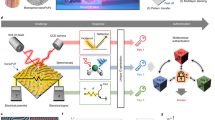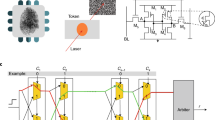Abstract
Disordered photonic structures are promising for the realization of physical unclonable functions—physical objects that can overcome the limitations of conventional digital security and can enable cryptographic protocols immune against attacks by future quantum computers. The physical configuration of traditional physical unclonable functions is either fixed or can only be permanently modified, allowing one token per device and limiting their practicality. Here we overcome this limitation by creating reconfigurable structures made by light-transformable polymers in which the physical structure of the unclonable function can be reconfigured reversibly. Our approach allows the simultaneous coexistence of multiple physical unclonable functions within one device. The physical transformation is done all-optically in a reversible and spatially controlled fashion, allowing the generation of more complex keys. At the same time, as a set of switchable individual physical unclonable functions, it enables the authentication of multiple clients and allows for the practical implementations of quantum secure authentication and nonlinear generators of cryptographic keys.
This is a preview of subscription content, access via your institution
Access options
Access Nature and 54 other Nature Portfolio journals
Get Nature+, our best-value online-access subscription
$29.99 / 30 days
cancel any time
Subscribe to this journal
Receive 12 print issues and online access
$259.00 per year
only $21.58 per issue
Buy this article
- Purchase on Springer Link
- Instant access to full article PDF
Prices may be subject to local taxes which are calculated during checkout






Similar content being viewed by others
Data availability
Data supporting the findings in the present work are available in the Article or its Supplementary Information. Additional data are available from the corresponding authors upon request or available via Zenodo at https://doi.org/10.5281/zenodo.8377156. Source data are provided with this paper.
References
Vynck, K., Burresi, M., Riboli, F. & Wiersma, D. S. Photon management in two-dimensional disordered media. Nat. Mater. 11, 7–12 (2012).
Wiersma, D. S. Disordered photonics. Nat. Photon. 7, 188–196 (2013).
Cao, H. & Eliezer, Y. Harnessing disorder for photonic device applications. Appl. Phys. Rev. 9, 011309 (2022).
López, C. The true value of disorder. Adv. Opt. Mater. 6, 1800439 (2018).
Mosk, A. P., Lagendijk, A., Lerosey, G. & Fink, M. Controlling waves in space and time for imaging and focusing in complex media. Nat. Photon. 6, 283–292 (2012).
Berkovits, R. Sensitivity of the multiple-scattering speckle pattern to the motion of a single scatterer. Phys. Rev. B 43, 8638 (1991).
Riboli, F. et al. Tailoring correlations of the local density of states in disordered photonic materials. Phys. Rev. Lett. 119, 043902 (2017).
Lio, G. E. et al. Quantifying the sensitivity and unclonability of optical physical unclonable functions. Adv. Photon. Res. 4, 2200225 (2022).
McGrath, T., Bagci, I. E., Wang, Z. M., Roedig, U. & Young, R. J. A PUF taxonomy. Appl. Phys. Rev. 6, 011303 (2019).
Rührmair, U. & Holcomb, D. E. PUFs at a glance. In 2014 Design, Automation & Test in Europe Conference & Exhibition (DATE) 1–6 (IEEE, 2014).
Gao, Y., Al-sarawi, S. F. & Abbott, D. Physical unclonable functions. Nat. Electron. 3, 81–91 (2020).
Lugli, P. et al. Physical unclonable functions based on crossbar arrays for cryptographic applications. Int. J. Circuit Theory Appl. 41, 619–633 (2013).
Rührmair, U. et al. Modeling attacks on physical unclonable functions. In Proc. 17th ACM Conference on Computer and Communications Security 237–249 (ACM, 2010).
Suh, G. E. and Devadas, S. Physical unclonable functions for device authentication and secret key generation. In Proc. 44th Annual Design Automation Conference 9–14 (2007).
Arppe, R. & Sørensen, T. J. Physical unclonable functions generated through chemical methods for anti-counterfeiting. Nat. Rev. Chem. 1, 0031 (2017).
Carro-Temboury, M. R., Arppe, R., Vosch, T. & Sørensen, T. J. An optical authentication system based on imaging of excitation-selected lanthanide luminescence. Sci. Adv. 4, e1701384 (2018).
Feng, J. et al. Random organic nanolaser arrays for cryptographic primitives. Adv. Mater. 31, 1807880 (2019).
Leem, J. W. et al. Edible unclonable functions. Nat. Commun. 11, 328 (2020).
Smith, A. F., Patton, P. & Skrabalak, S. E. Plasmonic nanoparticles as a physically unclonable function for responsive anti-counterfeit nanofingerprints. Adv. Funct. Mater. 26, 1315–1321 (2016).
Yao, W., Lan, R., Li, K. & Zhang, L. Multiple anti-counterfeiting composite film based on cholesteric liquid crystal and QD materials. ACS Appl. Mater. Interfaces 13, 1424–1430 (2021).
Bin Tarik, F., Famili, A., Lao, Y. & Ryckman, J. D. Robust optical physical unclonable function using disordered photonic integrated circuits. Nanophotonics 9, 2817–2828 (2020).
Fratalocchi, A., Fleming, A., Conti, C. & De Falco, A. NIST-certified secure key generation via deep learning of physical unclonable functions in silica aerogels. Nanophotonics 10, 457–464 (2021).
Di Falco, A., Mazzone, V., Cruz, A. & Fratalocchi, A. Perfect secrecy cryptography via mixing of chaotic waves in irreversible time-varying silicon chips. Nat. Commun. 10, 5827 (2019).
Pappu, R., Recht, B., Taylor, J. & Gershenfeld, N. Physical one-way functions. Science 297, 2026–2030 (2002).
Horstmeyer, R., Judkewitz, B., Vellekoop, I. M., Assawaworrarit, S. & Yang, C. Physical key-protected one-time pad. Sci. Rep. 3, 3543 (2013).
Horstmeyer, R., Assawaworrarit, S., Ruhrmair, U. & Yang, C. Physically secure and fully reconfigurable data storage using optical scattering. In 2015 IEEE International Symposium on Hardware Oriented Security and Trust (HOST) 157–162 (IEEE, 2015).
Bosworth, B. T. et al. Unclonable photonic keys hardened against machine learning attacks. APL Photonics 5, 010803 (2020).
Kursawe, K., Sadeghi, A. R., Schellekens, D., Škorić, B. & Tuyls, P. Reconfigurable physical unclonable functions—enabling technology for tamper-resistant storage. In 2009 IEEE International Workshop on Hardware-Oriented Security and Trust 22–29 (IEEE, 2009).
John, R. A. et al. Halide perovskite memristors as flexible and reconfigurable physical unclonable functions. Nat. Commun. 12, 3681 (2021).
Kim, Y. et al. Reconfigurable multilevel optical PUF by spatiotemporally programmed crystallization of supersaturated solution. Adv. Mater. 35, 2212294 (2023).
Gan, Z. et al. Reconfigurable optical physical unclonable functions enabled by VO2 nanocrystal films. ACS Appl. Mater. Interfaces 14, 5785–5796 (2022).
Burr, W. E. et al. Electronic Authentication Guideline, NIST Special Publication 800-63-2. 1–123 (2013).
Daugman, J. Information theory and the IrisCode. IEEE Trans. Inf. Forensics Security 11, 400–409 (2016).
Daugman, J. The importance of being random: statistical principles of iris recognition. Pattern Recognit. 36, 279–291 (2003).
Guo, S. M. et al. Preparation of a thermally light-transmittance-controllable film from a coexistent system of polymer-dispersed and polymer-stabilized liquid crystals. ACS Appl. Mater. Interfaces 9, 2942–2947 (2017).
Da Cunha, M. P., van Thoor, E. A., Debije, M. G., Broer, D. J. & Schenning, A. P. Unravelling the photothermal and photomechanical contributions to actuation of azobenzene-doped liquid crystal polymers in air and water. J. Mater. Chem. C 7, 13502–13509 (2019).
Khoo, I. C. and Wu, S. T. Optics and Nonlinear Optics of Liquid Crystals Vol. 1 (World Scientific, 1993).
Dierking, I. Polymer network-stabilized liquid crystals. Adv. Mater. 12, 167–181 (2000).
Lee, Y. H., Gou, F., Peng, F. & Wu, S. T. Hysteresis-free and submillisecond-response polymer network liquid crystal. Opt. Express 24, 14793–14800 (2016).
Rührmair, U., Hilgers, C. & Urban, S. Optical PUFs reloaded. IACR Cryptology (2013).
Uppu, R. et al. Asymmetric cryptography with physical unclonable keys. Quantum Sci. Technol. 4, 045011 (2019).
Barker, E. & Kelsey, J. Recommendation for the entropy sources used for random bit generation. NIST Special Publication 800–90B (2012).
Vijayakumar, A., Patil, V. C., Prado, C. B. & Kundu, S. Machine learning resistant strong PUF: possible or a pipe dream? In 2016 IEEE International Symposium on Hardware Oriented Security and Trust (HOST) 19–24 (IEEE, 2016).
Elbirt, A. J., Yip, W., Chetwynd, B. & Paar, C. An FPGA-based performance evaluation of the AES block cipher candidate algorithm finalists. IEEE Trans. Very Large Scale Integr. (VLSI) Syst. 9, 545–557 (2001).
Škorić, B., Pinkse, P. W. H. & Mosk, A. P. Authenticated communication from quantum readout of PUFs. Quantum Inf. Process. 16, 200 (2017).
Goorden, S. A., Horstmann, M., Mosk, A. P., Škoric, B. & Pinkse, P. W. H. Quantum-secure authentication of a physical unclonable key. Optica 1, 421–424 (2014).
Eliezer, Y., Rührmair, U., Wisiol, N., Bittner, S. and Cao, H. Tunable nonlinear optical mapping in a multiple-scattering cavity. Proceedings of the National Academy of Sciences, 120(31), p.e2305027120 (2023).
Ondris-Crawford, R. et al. Microscope textures of nematic droplets in polymer dispersed liquid crystals. J. Appl. Phys. 69, 6380–6386 (1991).
Cover, T. M. & Thomas, J. Chapter 2. Entropy, relative entropy and mutual information. in Elements of Information Theory Vol. 1 (John Wiley & Sons, 1991).
Scholz, A. et al. Hybrid low-voltage physical unclonable function based on inkjet-printed metal-oxide transistors. Nat. Commun. 11, 5543 (2020).
Tuyls, P., Škorić, B., Stallinga, S., Akkermans, A. H. M. & Ophey, W. Information-theoretic security analysis of physical uncloneable functions. Lect. Notes Comput. Sci. 3570, 141–155 (2005).
Arppe-Tabbara, R., Tabbara, M. & Sørensen, T. J. Versatile and validated optical authentication system based on physical unclonable functions. ACS Appl. Mater. Interfaces 11, 6475–6482 (2019).
Acknowledgements
The research leading to these results has received funding from AFOSR/RTA2 (A.2.e. Information Assurance and Cybersecurity) project ‘Highly Secure Nonlinear Optical PUFs’ (FA9550-21-1-0039) awarded to U.R., Ente Cassa di Risparmio di Firenze (2018/1047) awarded to F.R. and Fondo premiale FOE project ‘Volume photography: measuring three-dimensional light distributions without opening the box’ (E17G17000300001). This work was partially supported by project SERICS (PE00000014) under the MUR National Recovery and Resilience Plan funded by the European Union—NextGenerationEU and co-funded by the European Union—NextGenerationEU, ‘Integrated infrastructure initiative in Photonic and Quantum Sciences’—I-PHOQS (IR0000016, ID D2B8D520, CUP B53C22001750006). We thank H. Cao, Y. Eliezer, G.E. Lio, M. Lachner, N. Wisiol and A. Baliuka for feedback on the data within the AFOSR project. We thank D. Martella for discussions on chemistry and P. Pinkse for his inputs on the quantum secure authentication protocols.
Author information
Authors and Affiliations
Contributions
S.N., F.R. and U.R. conceived the experiment. S.N. fabricated the devices. S.N. performed the characterization and measurements. S.N. analysed the data. M.B. and D.S.W. helped with the data interpretation on the information theory aspects and scattering properties, respectively. U.R. helped with the security and PUF-related aspects. F.R. wrote the theoretical discussion. F.R. supervised the project. S.N. and F.R. wrote the paper, and all authors discussed the results and worked on the paper.
Corresponding authors
Ethics declarations
Competing interests
The authors declare no competing interests.
Peer review
Peer review information
Nature Materials thanks Thomas Just Sørensen and the other, anonymous, reviewer(s) for their contribution to the peer review of this work.
Additional information
Publisher’s note Springer Nature remains neutral with regard to jurisdictional claims in published maps and institutional affiliations.
Supplementary information
Supplementary Information
Supplementary Figs. 1–12 and Notes 1 and 2.
Source data
Source Data Fig. 2
Source data for Fig. 2h.
Source Data Fig. 3
Source data for Fig. 3b–d.
Source Data Fig. 4
Source data for the PCC graph.
Source Data Fig. 5
Source data for Fig. 5b,c.
Source Data Fig. 6
Source data for Fig. 6a.
Rights and permissions
Springer Nature or its licensor (e.g. a society or other partner) holds exclusive rights to this article under a publishing agreement with the author(s) or other rightsholder(s); author self-archiving of the accepted manuscript version of this article is solely governed by the terms of such publishing agreement and applicable law.
About this article
Cite this article
Nocentini, S., Rührmair, U., Barni, M. et al. All-optical multilevel physical unclonable functions. Nat. Mater. 23, 369–376 (2024). https://doi.org/10.1038/s41563-023-01734-7
Received:
Accepted:
Published:
Issue Date:
DOI: https://doi.org/10.1038/s41563-023-01734-7



